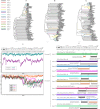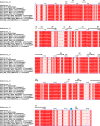Genotype F of Echovirus 25 with multiple recombination pattern have been persistently and extensively circulating in Chinese mainland
- PMID: 38332009
- PMCID: PMC10853551
- DOI: 10.1038/s41598-024-53513-2
Genotype F of Echovirus 25 with multiple recombination pattern have been persistently and extensively circulating in Chinese mainland
Abstract
Echovirus 25 (E25), a member of the Enterovirus B (EV-B) species, can cause aseptic meningitis (AM), viral meningitis (VM), and acute flaccid paralysis (AFP). However, systematic studies on the molecular epidemiology of E25, especially those concerning its evolution and recombination, are lacking. In this study, 18 strains of E25, isolated from seven provinces of China between 2009 and 2018, were collected based on the Chinese hand, foot, and mouth disease (HFMD) surveillance network, and 95 sequences downloaded from GenBank were also screened. Based on the phylogenetic analysis of 113 full-length VP1 sequences worldwide, globally occurring E25 strains were classified into 9 genotypes (A-I), and genotype F was the dominant genotype in the Chinese mainland. The average nucleotide substitution rate of E25 was 6.08 × 10-3 substitutions/site/year, and six important transmission routes were identified worldwide. Seventeen recombination patterns were determined, of which genotype F can be divided into 9 recombination patterns. A positive selector site was found in the capsid protein region of genotype F. Recombination analysis and pressure selection analysis for genotype F showed multiple recombination patterns and evolution characteristics, which may be responsible for it being the dominant genotype in the Chinese mainland. This study provides a theoretical basis for the subsequent prevention and control of E25.
© 2024. The Author(s).
Conflict of interest statement
The authors declare no competing interests.
Figures





References
MeSH terms
Grants and funding
LinkOut - more resources
Full Text Sources

